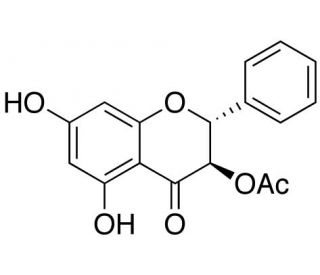

Molecular structure of Pinobanksin acetate, CAS Number: 52117-69-8
Pinobanksin acetate (CAS 52117-69-8)
Alternate Names:
Pinobankasin 3-Acetate; 3-O-Acetylpinobanksin
CAS Number:
52117-69-8
Molecular Weight:
314.29
Molecular Formula:
C17H14O6
For Research Use Only. Not Intended for Diagnostic or Therapeutic Use.
* Refer to Certificate of Analysis for lot specific data.
QUICK LINKS
Ordering Information
Description
Technical Information
Safety Information
SDS & Certificate of Analysis
Pinobanksin acetate functions as a potent antioxidant in experimental applications. It exerts its mechanism of action by scavenging free radicals and inhibiting oxidative stress at the molecular level. Pinobanksin Acetate is known to modulate various cellular signaling pathways, including those involved in inflammation and apoptosis. Pinobanksin acetate may interact with specific enzymes and proteins, regulating their activity and expression. Its role in regulating cellular redox balance and signaling pathways may be a relevant compound for understanding the molecular basis of oxidative stress-related pathologies.
Pinobanksin acetate (CAS 52117-69-8) References
- [On the antimicrobial activity of propolis and propolis constituents (author's transl)]. | Metzner, J., et al. 1979. Pharmazie. 34: 97-102. PMID: 108687
- Trypanocidal activity of Lychnophora staavioides Mart. (Vernonieae, Asteraceae). | Takeara, R., et al. 2003. Phytomedicine. 10: 490-3. PMID: 13678232
- Analysis of the polyphenolic fraction of propolis from different sources by liquid chromatography-tandem mass spectrometry. | Gardana, C., et al. 2007. J Pharm Biomed Anal. 45: 390-9. PMID: 17935924
- Sonoran propolis: chemical composition and antiproliferative activity on cancer cell lines. | Hernandez, J., et al. 2007. Planta Med. 73: 1469-74. PMID: 17948188
- Identification and quantification of phytochemical composition and anti-inflammatory and radical scavenging properties of methanolic extracts of Chinese propolis. | Shi, H., et al. 2012. J Agric Food Chem. 60: 12403-10. PMID: 23176258
- Propolis chemical composition and honeybee resistance against Varroa destructor. | Popova, M., et al. 2014. Nat Prod Res. 28: 788-94. PMID: 24483289
- Chemical Composition of Different Botanical Origin Honeys Produced by Sicilian Black Honeybees (Apis mellifera ssp. sicula). | Mannina, L., et al. 2015. J Agric Food Chem. 63: 5864-74. PMID: 25730368
- Identification of Hypotensive Biofunctional Compounds of Coriandrum sativum and Evaluation of Their Angiotensin-Converting Enzyme (ACE) Inhibition Potential. | Hussain, F., et al. 2018. Oxid Med Cell Longev. 2018: 4643736. PMID: 30581531
- European propolis is highly active against trypanosomatids including Crithidia fasciculata. | Alotaibi, A., et al. 2019. Sci Rep. 9: 11364. PMID: 31388043
- Chemical Profile and Antibacterial Activity of a Novel Spanish Propolis with New Polyphenols also Found in Olive Oil and High Amounts of Flavonoids. | Fernández-Calderón, MC., et al. 2020. Molecules. 25: PMID: 32707882
- Untargeted Ultrahigh-Performance Liquid Chromatography-Hybrid Quadrupole-Orbitrap Mass Spectrometry (UHPLC-HRMS) Metabolomics Reveals Propolis Markers of Greek and Chinese Origin. | Stavropoulou, MI., et al. 2021. Molecules. 26: PMID: 33467182
- Phytochemical Profile, Plant Precursors and Some Properties of Georgian Propolis. | Okińczyc, P., et al. 2022. Molecules. 27: PMID: 36431810
Ordering Information
| Product Name | Catalog # | UNIT | Price | Qty | FAVORITES | |
Pinobanksin acetate, 2.5 mg | sc-476238 | 2.5 mg | $340.00 |
